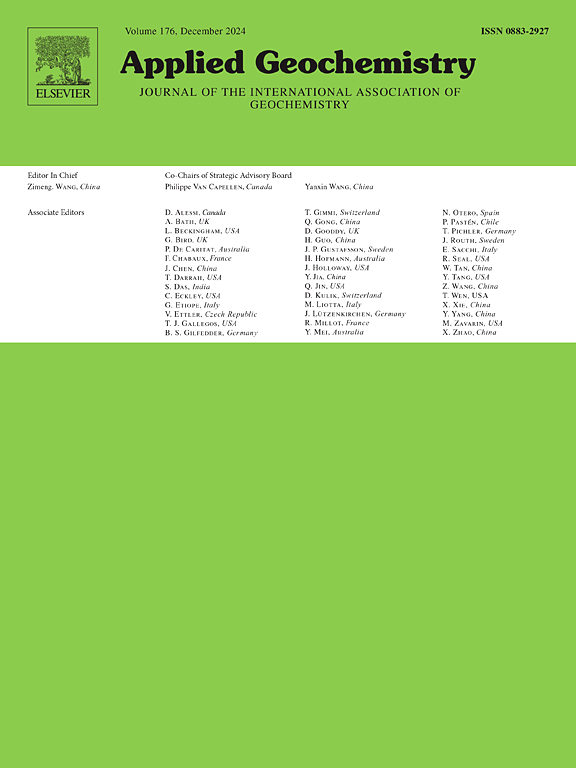Monsoonal rainfall initiates autochthonous alteration of dissolved organic matter composition in Indian groundwaters
IF 3.1
3区 地球科学
Q1 GEOCHEMISTRY & GEOPHYSICS
引用次数: 0
Abstract
Groundwater contamination is a considerable threat to public health in many regions of the world. Strong seasonal variation in monsoon-affected regions can have significant effects on groundwater quality, yet these variations are not fully understood. Using excitation-emission matrix (EEM) fluorescent spectroscopy, we explore the seasonal dynamics of dissolved organic matter (DOM) composition along a transect in West Bengal, India. Groundwater, river water and ponds were sampled (n = 59) on a weekly/fortnightly basis, from the onset of monsoon to late-July, to gain an understanding of DOM temporal dynamics in aquifers at a critical point in seasonal hydrological conditions. Several fluorescent DOM (fDOM) components and indices were used to infer the source and nature of DOM. Although dissolved organic carbon (DOC) remained consistent throughout the sample timeframe, precipitation-associated spikes in fluorescence index (FI), specific ultraviolet absorbance (SUVA254) and redox potential (Eh) likely point towards rainfall-induced increase of autochthonous DOM and the increase of microbial metabolic activity in response to oxygenated recharge. We suggest that observed fluctuations in organics were associated with concomitant changes in redox- and solubility-controlled elements (e.g. Fe and Mg), thus having wider implications on groundwater geochemistry and particularly the mobility of redox- and organic-sensitive solutes.
季风降雨引发了印度地下水中溶解有机质组成的原生变化
在世界许多地区,地下水污染对公众健康构成相当大的威胁。受季风影响地区强烈的季节变化可能对地下水质量产生重大影响,但这些变化尚未完全了解。利用激发-发射矩阵(EEM)荧光光谱,我们探索了印度西孟加拉邦样带溶解有机物(DOM)组成的季节性动态。从季风开始到7月下旬,每隔一周或两周对地下水、河水和池塘进行采样(n = 59),以了解季节性水文条件临界点下含水层DOM的时间动态。利用几种荧光DOM (fDOM)成分和指标来推断DOM的来源和性质。尽管溶解有机碳(DOC)在整个样品时间框架内保持一致,但与降水相关的荧光指数(FI)、特定紫外线吸收(SUVA254)和氧化还原电位(Eh)的峰值可能指向降雨引起的原生DOM的增加和微生物代谢活性的增加,以响应氧补给。我们认为,观测到的有机物波动与氧化还原和溶解度控制元素(如铁和镁)的伴随变化有关,因此对地下水地球化学,特别是氧化还原和有机敏感溶质的流动性具有更广泛的影响。
本文章由计算机程序翻译,如有差异,请以英文原文为准。
求助全文
约1分钟内获得全文
求助全文
来源期刊

Applied Geochemistry
地学-地球化学与地球物理
CiteScore
6.10
自引率
8.80%
发文量
272
审稿时长
65 days
期刊介绍:
Applied Geochemistry is an international journal devoted to publication of original research papers, rapid research communications and selected review papers in geochemistry and urban geochemistry which have some practical application to an aspect of human endeavour, such as the preservation of the environment, health, waste disposal and the search for resources. Papers on applications of inorganic, organic and isotope geochemistry and geochemical processes are therefore welcome provided they meet the main criterion. Spatial and temporal monitoring case studies are only of interest to our international readership if they present new ideas of broad application.
Topics covered include: (1) Environmental geochemistry (including natural and anthropogenic aspects, and protection and remediation strategies); (2) Hydrogeochemistry (surface and groundwater); (3) Medical (urban) geochemistry; (4) The search for energy resources (in particular unconventional oil and gas or emerging metal resources); (5) Energy exploitation (in particular geothermal energy and CCS); (6) Upgrading of energy and mineral resources where there is a direct geochemical application; and (7) Waste disposal, including nuclear waste disposal.
 求助内容:
求助内容: 应助结果提醒方式:
应助结果提醒方式:


